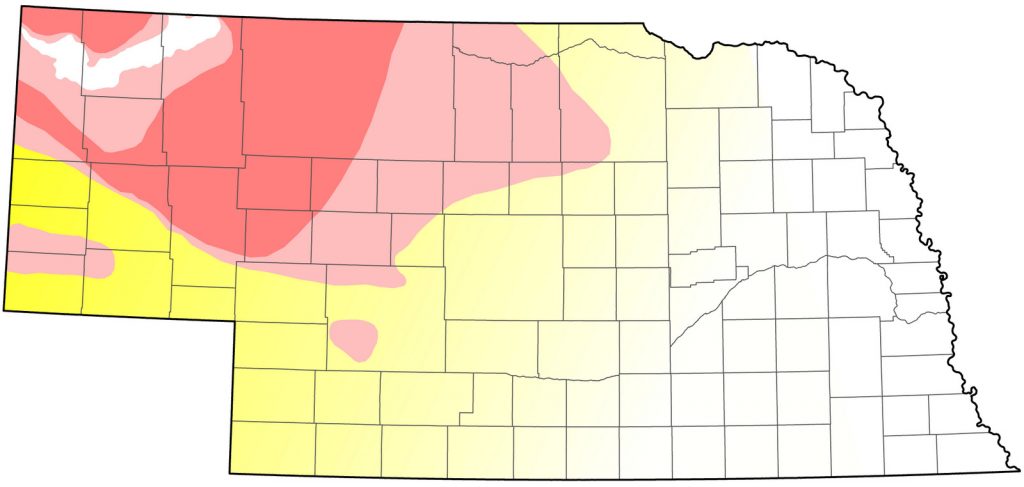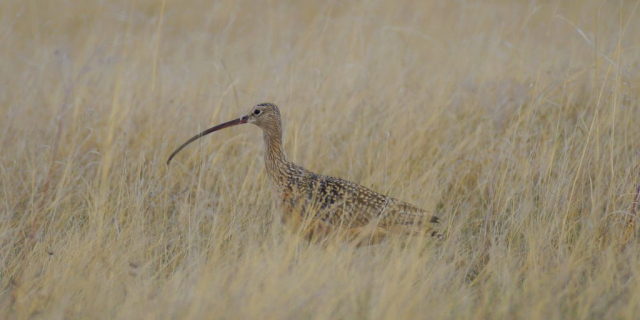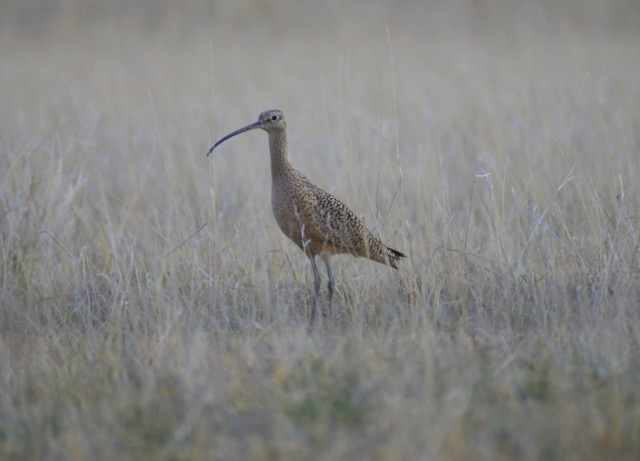Numenius americanus
Status: Decreasing. Fairly common regular spring and fall migrant central and west, rare casual east. Fairly common regular breeder north-central and west.

Documentation: Specimen: UNSM ZM6609, 20 Jun 1901 Indian Creek, Sioux Co.
Taxonomy: Current authorities treat this species as monotypic (Dugger and Dugger 2020, AviList 2025).
Two poorly defined subspecies, parvus of southwest Canada to California and americanus of the western United States, have been previously recognized by some authorities (Clements et al 2016).
Nebraska birds are intergrades if the subspecies are recognized, given the ranges outlined by AOU (1957).
Spring: Mar 27, 28, 29 <<<>>> summer
Earlier dates are 22 Mar 2012 Crescent Lake NWR, Cherry Co, 24 Mar 2016 Frontier Co, and 25 Mar 2017 Lincoln Co.
Arrival is relatively early, often by the last week of Mar, with a peak in Apr. A bird named “Bailey”, outfitted with a satellite transmitter in Garden County, Nebraska, left her northeast Mexico winter location 8 Apr 2010, arrived in Garden Co 9 Apr, and settled in 11 miles northeast of her previous year’s nesting site; in 2011 Bailey left northeast Mexico 29 Mar and arrived in the western Sandhills 1 Apr (NGPC, unpublished data).
Easterly records are few, even in the Rainwater Basin. One in Fillmore Co 27 Apr 2003 was the first record for the eastern Rainwater Basin for 50 years; but in the following years, 2004-2013, there were no fewer than 12 records 30 Mar-27 Apr, most of these cited by Jorgensen (2012). There have been no Rainwater Basin records since 2013.
Easterly records away from the Rainwater Basin are few, only seven, three of which were in 2013: 13 Apr at a sod farm, Sarpy Co, 15 Apr at Jack Sinn WMA, Lancaster Co, and two birds likely this species near Talmage, Otoe Co 27 Apr. Others were of one downed in a snowstorm in Albion, Boone Co 26 Mar 1983 (Wayne Mollhoff, personal communication), 13 Apr 2024 at Branched Oak Lake, Lancaster Co, 15 Apr 2022 at Lakes North and Babcock, Platte Co, and 17-18 Apr 2025 at Wagon Train RA, Lancaster Co.
- High counts: 30+ at North Platte, Lincoln Co 1 Apr 2003, 26 at Lake Ogallala, Keith Co 2 May 1998, 25 around North Platte 15 Apr 2014, and 23 at Lake McConaughy 20 Apr 2013.
Summer: The Long-billed Curlew’s historical breeding range formerly included all of Nebraska (Ducey 2000), extending as far east as Illinois, but had decreased markedly by 1900 (Dugger and Dugger 2020). A few old nesting records exist from eastern Nebraska; adults and young were in Platte Co on the Stephen Long Expedition 8 Jun 1820 (James 1972, Mollhoff 2022), Cary (1900) noted that the Long-billed Curlew was “formerly common but is now quite rare” in Antelope Co in Nebraska, and a nest with eggs was collected in Pierce Co May 1887 (Spink, in Mollhoff 2022). By the early 1900s Long-billed Curlew was restricted to western Nebraska as “a common breeder locally from Cherry County westward” (Bruner et al 1904). The breeding range has remained relatively stable since. Long-billed Curlews became less common in the east and south of the Sandhills as the prairies were converted to agriculture; the species has not summered in the Keystone Lake, Keith Co area since irrigators were installed in the 1990s (Brown et al 2012). Since 1925, there have been fewer than 20 reports east of the Sandhills and south of the Platte River.
Nebraska’s breeding population has been estimated at 23,909 individuals (95% CI: 20,810—27,471; Gregory et al 2011). Breeding densities are highest in the western Sandhills, primarily the “lake country” that includes southern Sheridan, northern Garden, western Cherry, Arthur, and Grant Cos (Gregory et al 2011, Rosche 1982). It also breeds commonly on the Ogallala National Grasslands in Sioux Co (Rosche 1982).
Although the Nebraska Sandhills appear to be a major stronghold for the species (Gregory et al 2011), declines in Nebraska are apparently ongoing. BBS trend analysis for 1966-2019 (Sauer et al 2020) shows Long-billed Curlews declining -3.50% (95% C.I.; -6.48 to -0.63) annually in the state. A recent study in the western Sandhills 2008-2010 showed nest success was about 30% and negatively associated with the presence of tall vegetation near the nest site (Gregory et al 2011). The same study also showed chick survival from hatching to fledging was only 4% (n = 28; Gregory 2011).
The southern and eastern limits of the breeding range are not well defined, but the species may breed at very low densities in the southern Panhandle and in Sandhills east of Cherry County. A single bird was sighted in northeastern Keya Paha Co during a Burrowing Owl survey summer 2020 (Thiele et al 2021).
The few breeding season reports from the southern Panhandle are of a pair west of Long Canyon in Banner Co 3 May 1997, 14 in the same general area and courting 8 Apr 2000, one calling in suitable breeding habitat in southern Kimball Co 9 May 1998, and a pair in northern Cheyenne Co that raised chicks in 2007 and 2008.
There are a few breeding season reports from the southwest, but there has been no evidence of breeding: Jun or Jul 1970, 1972, and 1974, and 2 Jun 1992 in Perkins Co, 23 May-30 Jun 1988 in Chase Co, and pairs in southwest Lincoln Co 2 Jun 2003 and 11 Jun 2007 and one near Wellfleet, Lincoln Co 13 Jun 2018. Tout (1947) described it as a “summer resident and breeder” in Lincoln Co. The species formerly was a common breeder on the northeastern plains of Colorado (Andrews and Righter 1992).
Eastward, breeding apparently occurs on occasion in Brown, Rock, and Holt Cos (Mossman and Brogie 1983, Blake and Ducey 1991) and Garfield Co (Ducey 1988).
- Breeding phenology:
Eggs: 15 Apr-16 Jun
Young; 3 Jun-24 Jul
Fall: summer <<<>>> Aug 31, Sep 1, 2
Later dates are 4 Sep 2021 Kiowa WMA, Scotts Bluff Co, 5 Sep 2022 Lake Minatare, Scotts Bluff Co, 5-6 Sep 2021 Lake McConaughy, Keith Co, 10 Sep 1977 Garden Co, 13 Sep 1997 Phelps Co (Jorgensen 2012), and 14 Sep 2008 Arthur Co.
Post-breeding grouping and fall migration by Long-billed Curlews commences early. Failed breeders may migrate by early Jun or even May. Two females outfitted with satellite transmitters that nested in Garden Co in 2009 both had nests that were depredated. One of these two females migrated south on 19 Jun and arrived on wintering grounds in northeast Tamaulipas, Mexico, 29 Jun, and the other female departed 29 Jun (NGPC, unpublished data). One of these birds departed Nebraska 12 May 2010 and flew 360 miles to the Oklahoma Panhandle. Presumably its nest was also lost soon after egg-laying (NGPC, unpublished data).
Female Long-billed Curlews leave males attending broods several weeks after hatching (Dugger and Dugger 2020). By late Jun curlews begin forming flocks (Brown et al 1996); flocks of as many as 30 birds, which may have included failed breeders, were observed as early as 10 Jun 1997 at Crescent Lake NWR, Garden Co. A flock of 11 was in Kimball Co 2 Jul 2020.
Additional early fall migrants away from breeding areas were one at Harlan Co Reservoir, Harlan Co 20 Jun 2004, one in southeast Lincoln Co 23 Jun 2005, two in Perkins Co 24 Jun 2024, and a large group of 200 in Garden Co 12 Jul 2004. During Jul, numbers decline, and most are gone by Aug. Tout’s (1947) latest date from Lincoln Co is 22 Jul, and last dates from southern Sioux Co were 22 Jul 2009 and 31 Jul 2008. Most of the Aug reports are from the first half of the month, and there are only seven reports for Sep, most undocumented.
The species is casual in the east in fall with only four recent records; two were found at separate sites along the Platte River between Columbus and North Bend 27 Jun 2012, one was at Conestoga Lake, Lancaster Co 23 Jul 2016, one was at Tamora WPA, Seward Co 1 Sep 2017, and one was at Funk WPA, Phelps Co 13 Sep 1997.
- High counts: 200 in Garden Co 12 Jul 2004, 75 near Scottsbluff, Scotts Bluff Co late Aug 1929 (Swenk 1929), and 70 at Winters Creek Lake, Scotts Bluff Co 23 Jul 2005.
Images
Abbreviations
AOU: American Ornithologists’ Union
NGPC: Nebraska Game and Parks Commission
NWR: National Wildlife Refuge
UNSM: University of Nebraska State Museum
WMA: Wildlife Management Area (State)
WPA: Waterfowl Production Area (Federal)
Literature Cited
Andrews, R., and R. Righter. 1992. Colorado birds. Denver Museum of Natural History, Denver, Colorado, USA.
American Ornithologists’ Union [AOU]. 1957. The AOU Check-list of North American birds, 5th ed. Port City Press, Baltimore, Maryland, USA.
AviList Core Team, 2025. AviList: The Global Avian Checklist, v2025. https://doi.org/10.2173/avilist.v2025.
Blake, L., and J. E. Ducey. 1991. Birds of the eastern Sandhills in Holt County, Nebraska. NBR 59: 103-132.
Brown, C.R., M.B. Brown, P.A. Johnsgard, J. Kren, and W.C. Scharf. 1996. Birds of the Cedar Point Biological Station area, Keith and Garden Counties, Nebraska: Seasonal occurrence and breeding data. Transactions of the Nebraska Academy of Sciences 23: 91-108.
Brown, M.B., S.J. Dinsmore, and C.R. Brown. 2012. Birds of Southwestern Nebraska. University of Nebraska- Lincoln, Lincoln, Nebraska, USA.
Bruner, L., R.H. Wolcott, and M.H. Swenk. 1904. A preliminary review of the birds of Nebraska, with synopses. Klopp and Bartlett, Omaha, Nebraska, USA.
Cary, M. 1900. Some bird notes From the Upper Elkhorn. Proceedings of Nebraska Ornithologists’ Union 1: 21-29.
Clements, J. F., T. S. Schulenberg, M. J. Iliff, D. Roberson, T. A. Fredericks, B. L. Sullivan, and C. L. Wood. 2016. The eBird/Clements checklist of birds of the world: v2016, accessed 30 January 2018.
Ducey, J.E. 1988. Nebraska birds, breeding status and distribution. Simmons-Boardman Books, Omaha, Nebraska, USA.
Ducey, J.E. 2000. Birds of the Untamed West. The History of Birdlife in Nebraska, 1750 to 1875. Making History Press, Omaha, Nebraska, USA.
Dugger, B.D. and K.M. Dugger. 2020. Long-billed Curlew (Numenius americanus), version 1.0. In Birds of the World (A. F. Poole and F. B. Gill, Editors). Cornell Lab of Ornithology, Ithaca, NY, USA. https://doi.org/10.2173/bow.lobcur.01.
Gregory, C.J., S.J. Dinsmore, L.A, Powell, L.A., and J.G. Jorgensen. 2011. Nest survival of Long-billed Curlew in Nebraska. Wader Study Group Bulletin 118: 109-113.
James, E. 1972. Account of an expedition from Pittsburgh to the Rocky Mountains. Imprint Society, Barre, MA.
Jorgensen, J.G. 2012. Birds of the Rainwater Basin, Nebraska. Nebraska Game and Parks Commission, Lincoln, Nebraska, USA.
Mollhoff, W.J. 2022. Nest records of Nebraska birds. Nebraska Ornithologists’ Union Occasional Paper Number 9.
Mossman, M.J., and M.A. Brogie. 1983. Breeding status of selected bird species on the Niobrara Valley Preserve, Nebraska. NBR 51: 52-62.
Rosche, R.C. 1982. Birds of northwestern Nebraska and southwestern South Dakota, an annotated checklist. Cottonwood Press, Crawford, Nebraska, USA.
Sauer, J.R., W.A. Link, and J.E. Hines. 2020. The North American Breeding Bird Survey, Analysis Results 1966 – 2019: U.S. Geological Survey data release, https://doi.org/10.5066/P96A7675.
Swenk, M.H. 1929. Letters of Information. 44: 6.
Thiele, J., M. Brogie, J. Corman, S. Nevison, R. Olson, K, Schumacher, and C. Wessel. 2021. 2020 Keya Paha River Watershed Burrowing Owl Surveys, Including Records of Other At-risk Species – Final Report. Nebraska Game and Parks Commission, Norfolk, Nebraska, USA.
Tout, W. 1947. Lincoln County birds. Published by the author, North Platte, Nebraska, USA.
Recommended Citation
Silcock, W.R., and J.G. Jorgensen. 2025. Long-billed Curlew (Numenius americanus). In Birds of Nebraska — Online. www.BirdsofNebraska.org
Birds of Nebraska – Online
Updated 1 Aug 2025


